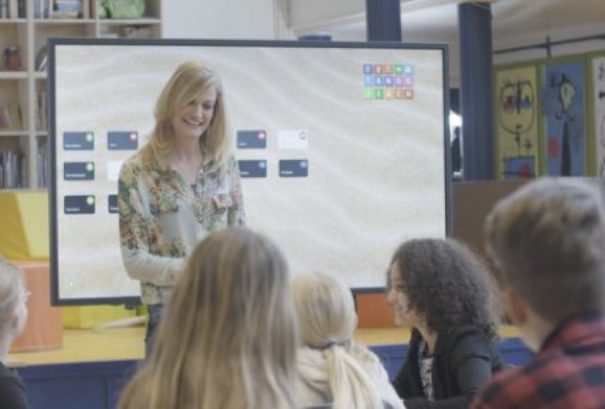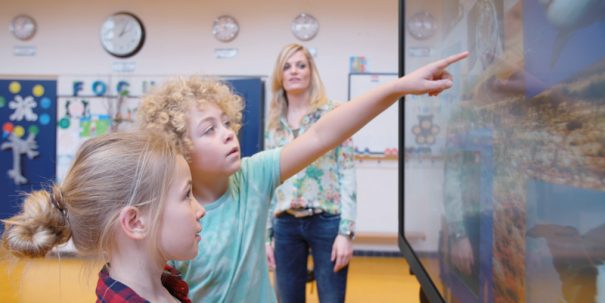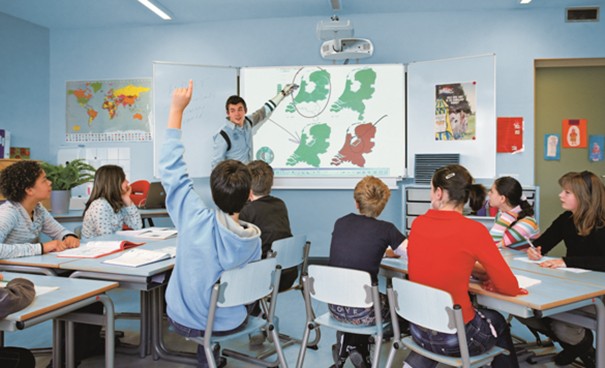La pizarra digital interactiva se convierte en el elemento TIC más utilizado en el aula
Los docentes reconocen que tanto la pizarra digital interactiva como la pantalla táctil de gran formato aportan cuatro elementos vitales a la educación: interactividad, colaboración bi-direccional, acceso a contenidos digitales casi ilimitados y un acercamiento al universo digital.
La pizarra digital interactiva (PDI) es un elemento TIC que está cada vez más presente en los centros educativos, según se pone de relieve en el último informe anual ‘La Sociedad en Red’ realizado por el Observatorio Nacional de Telecomunicaciones y Sociedad de la Información (Ontsi). The 85% de aulas españolas de educación reglada está equipada con al menos una PDI, porcentaje que alcanza el 90% en primaria y 78% en secundaria.
Además del equipamiento del aula, el estudio muestra que un porcentaje muy elevado de docentes españoles integra las TIC en la programación didáctica diaria y hasta un 75% la utiliza al menos una vez por semana.
Para Stephen Bernard, responsable de la marca Legamaster in Spain: “El equipamiento de las aulas ya es una herramienta obligatoria en las aulas del siglo XXI. Nevertheless, queda pendiente resolver el cambio metodológico para sacar el máximo partido de las nuevas tecnologías en los centros. Los docentes cada vez son más conscientes de los beneficios que aportan las TIC a la educación y, to this day, la mayoría reconoce que tanto la Pizarra Digital Interactiva como la pantalla táctil de gran formato han aportado cuatro elementos vitales: interactividad, colaboración bi-direccional, acceso a contenidos digitales casi ilimitados y un acercamiento al universo digital que viven los alumnos de hoy en día”.
El estudio revela que el 83% del profesorado cree que los alumnos muestran mayor interés y se sienten más motivados si se utilizan las TIC en clase. La visión del alumnado es muy similar. The 93% cree que el aprendizaje a través de las nuevas tecnologías es mucho más interesante y un 72% considera que la adquisición de conocimientos le resulta más fácil gracias a las TIC.
En relación a la dificultad de su uso, casi en su totalidad aseguran que su manejo es sencillo. Entre las actividades más realizadas con la PDI, destacan los ejercicios y trabajos en grupo, las explicaciones de las unidades didácticas y la búsqueda de recursos educativos.
“Estos datos muestran el cambio de actitud de los docentes en cuanto al uso de las TICs en la educación. Aunque son cifras muy positivas, es necesario que el sector educativo siga evolucionando al ritmo que lo hace la propia tecnología. Desde Legamaster proponemos dar un paso más e integrar los displays interactivos multitáctiles, que multiplican las posibilidades de aprendizaje respecto a otras tecnologías como las PDIs que se están quedando obsoletas”, explica Bernard.
Los displays ETX de Legamaster reconocen el toque de varios alumnos trabajando simultáneamente lo que favorece el trabajo colaborativo y la realización de ejercicios en grupo sobre la pantalla. In addition, incluyen sistema Android 5.0 integrado lo que posibilita su funcionamiento sin necesidad de disponer de un ordenador. Bernard asegura que su manejo “es incluso más sencillo e intuitivo que tecnologías anteriores”.
Obstáculos para incorpora las TIC en las aulas
Aunque los datos son esperanzadores en cuanto a la evolución de las TIC en el sector educativo, el informe también señala cuáles son los principales obstáculos que encuentran los docentes a la hora de incorporar las nuevas tecnologías a las aulas.
Más del 50% del profesorado reclama una mayor formación en TIC ya que, aunque se sienten preparados en la materia que van a impartir, sólo un 15% asegura tener la soltura necesaria para usarla en el aula delante de los alumnos.
“La mayor parte del profesorado manifiesta necesitar más formación en habilidades TIC que les permitan ser más eficaces delante del alumnado. Es esencial mejorar los conocimientos generales de informática de los docentes desde la universidad. Si queremos que la integración de la tecnología en el aula sea una realidad y, therefore, conseguir una educación útil y acorde con mundo de hoy”, concluye Bernard.
You liked this article?
Subscribe to our Feed And you won't miss a thing.

















